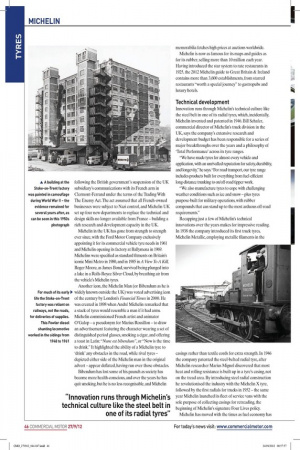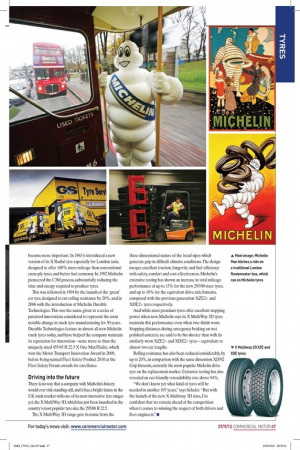n a ro
Page 35

Page 37

Page 38

If you've noticed an error in this article please click here to report it so we can fix it.
Since it established its tyre business in the UK 107 years ago Michelin has gone from strength to strength, a position that is unlikely to change in the future
Words: Barry Drew One day in 1891 a cyclist showed up at Edouard and André Michelin’s rubber factory in Clermont-Ferrand, France, with a tyre that needed repairing. The brothers did this in an overnight procedure that involved removing, then re-gluing the tyre to the bicycle’s wheel, and this set Edouard on a mission to create a tyre that did not need to be glued to the rim.
Fourteen years later – 1905, the same year Commercial Motor published its irst issue – Michelin’s tyre business was successful enough for the brothers to incorporate it in the UK. It is now a leading tyre player around the world, with a sales network covering more than 170 countries, and producing 150 million tyres a year. This has included manufacturing tyres for Nasa’s space shuttles prior to the leet of orbiters being retired in 2011. Indeed, the company invests more on research and development each year – €500 million (£395.6 million) – than any of its competitors.
In the UK today, Michelin is the number one tyre manufacturer in the truck tyre replacement market, with the largest number of road staff visiting hauliers and own-account operators on a daily basis. It makes new truck tyres for the European and US markets at its production facility in Ballymena, Northern Ireland – which has just celebrated manufacturing its 30 millionth tyre – and has an extensive truck tyre remoulding operation opposite its headquarters in Stoke-on-Trent.
Following the launch of Michelin’s new 295/80 R 22.5 X MultiWay 3D XZE steer tyre, with the matching drive itment joining the range soon, the company is once again poised to introduce one of the most innovative new products in the market. But how did Michelin UK get here?
Pumping up Britain’s expectations
André and Edouard Michelin always had big ideas for Britain, running advertisements in the British press in 1914, calling for a Channel Tunnel to be constructed linking England with France – a vision that would be realised some 80 years later. The company’s bespoke ofice building on the Fulham Road in London was used as a headquarters from 1911 until Michelin sold it to the Conran Octopus publishing group, heralding its eventual conversion into a restaurant and shop. The Grade II listed building remains one of London's most recognisable landmarks.
Michelin tyres shod the irst motorised taxis in London in 1907, and André Michelin petitioned the British government for the numbering of roads in 1912. Nine years later the British Ministry of Transportation saw the wisdom of his idea and André was on hand to offer it advice. Michelin published the irst UK road map with road numbers in 1921.
The company opened its irst British factory in Stoke-on-Trent in 1927, responding to hefty import duties on foreign vehicle components introduced by the British government. During the Second World War Michelin UK very quickly had to become self-suficient following the British government’s suspension of the UK subsidiary’s communications with its French arm in Clermont-Ferrand under the terms of the Trading With The Enemy Act. The act assumed that all French-owned businesses were subject to Nazi control, and Michelin UK set up four new departments to replace the technical and design skills no longer available from France – building a rich research and development capacity in the UK.
Michelin in the UK has gone from strength to strength ever since, with the Ford Motor Company exclusively appointing it for its commercial vehicle tyre needs in 1961 and Michelin opening its factory at Ballymena in 1969. Michelins were speciied as standard itments on Britain’s iconic Mini Metro in 1980, and in 1985 in A View To A Kill, Roger Moore, as James Bond, survived being plunged into a lake in a Rolls-Royce Silver Cloud, by breathing air from the vehicle’s Michelin tyres.
Another icon, the Michelin Man (or Bibendum as he is widely known outside the UK) was voted advertising icon of the century by London’s Financial Times in 2000. He was created in 1898 when André Michelin remarked that a stack of tyres would resemble a man if it had arms. Michelin commissioned French artist and animator O’Galop – a pseudonym for Marius Rossillon – to draw an advertisement featuring the character wearing a set of distinguished period glasses, smoking a cigar, and offering a toast in Latin: “Nunc est bibendum”, or “Now is the time to drink.” It highlighted the ability of a Michelin tyre to ‘drink’ any obstacles in the road, while rival tyres – depicted either side of the Michelin man in the original advert – appear delated, having run over those obstacles.
Bibendum has lost some of his paunch as society has become more health-conscious, and over the years he has quit smoking, but he is no less recognisable, and Michelin memorabilia fetches high prices at auctions worldwide.
Michelin is now as famous for its maps and guides as for its rubber, selling more than 10 million each year. Having introduced the star system to rate restaurants in 1925, the 2012 Michelin guide to Great Britain & Ireland contains more than 3,600 establishments, from starred restaurants “worth a special journey” to gastropubs and luxury hotels.
Technical development
Innovation runs through Michelin’s technical culture like the steel belt in one of its radial tyres, which, incidentally, Michelin invented and patented in 1946. Bill Schafer, commercial director of Michelin’s truck division in the UK, says the company’s extensive research and development budget has been responsible for a series of major breakthroughs over the years and a philosophy of ‘Total Performance’ across its tyre ranges.
“We have made tyres for almost every vehicle and application, with an unrivalled reputation for safety, durability, and longevity,” he says. “For road transport, our tyre range includes products built for everything from fuel-eficient long-distance trunking to on/off-road tipper work.
“We also manufacture tyres to cope with challenging weather conditions such as ice and snow – plus tyres purpose-built for military operations, with rubber compounds that can stand up to the most arduous off-road requirements.” Recapping just a few of Michelin’s technical innovations over the years makes for impressive reading. In 1938 the company introduced its irst truck tyres, Michelin Metallic, employing metallic ilaments in the casings rather than textile cords for extra strength. In 1946 the company patented the steel-belted radial tyre, after Michelin researcher Marius Mignol discovered that most heat and rolling resistance is built up in a tyre’s casing, not on the tread area. By introducing steel radial construction he revolutionised the industry with the Michelin X tyre, followed by the irst radials for trucks in 1952 – the same year Michelin launched its leet of service vans with the sole purpose of collecting casings for retreading, the beginning of Michelin’s signature Four Lives policy.
Michelin has moved with the times as fuel economy has become more important. In 1963 it introduced a new version of its X Radial tyre especially for London taxis, designed to offer 100% more mileage than conventional cross-ply tyres, and better fuel economy. In 1992 Michelin pioneered the C3M process, substantially reducing the time and energy required to produce tyres.
This was followed in 1994 by the launch of the ‘green’ car tyre, designed to cut rolling resistance by 20%, and in 2006 with the introduction of Michelin Durable Technologies. This was the name given to a series of patented innovations considered to represent the most notable change in truck tyre manufacturing for 50 years. Durable Technologies feature in almost all new Michelin truck tyres today, and have helped the company maintain its reputation for innovation – none more so than the uniquely sized 455/45 R 22.5 X One MaxiTrailer, which won the Motor Transport Innovation Award in 2009, before being named Fleet Safety Product 2010 at the Fleet Safety Forum awards for excellence.
Driving into the future
There is no way that a company with Michelin’s history would ever risk standing still, and it has a bright future in the UK truck market with one of its most innovative tyre ranges yet, the X MultiWay 3D, which has just been launched in the country’s most popular tyre size, the 295/80 R 22.5.
The X MultiWay 3D range gets its name from the three-dimensional nature of the tread sipes which generate grip in dificult climatic conditions. The design merges excellent traction, longevity and fuel-eficiency with safety, comfort and cost-effectiveness. Michelin’s extensive testing has shown an increase in total mileage performance of up to 15% for the new 295/80 steer tyres, and up to 10% for the equivalent drive axle itments, compared with the previous generation XZE2+ and XDE2+ tyres respectively.
And while most premium tyres offer excellent stopping power when new, Michelin says its X MultiWay 3D tyres maintain this performance even when two-thirds worn. Stopping distances during emergency braking on wet polished concrete are said to be 8m shorter than with its similarly worn XZE2+ and XDE2+ tyres – equivalent to almost two car lengths.
Rolling resistance has also been reduced considerably, by up to 20%, in comparison with the same dimension XDN2 Grip itments, currently the most popular Michelin drive tyre on the replacement market. Extensive testing has also revealed an eco-friendly retreadability rate above 94%.
“We don’t know yet what kind of tyres will be needed in another 107 years,” says Schafer. “But with the launch of the new X Multiway 3D sizes, I’m conident that we remain ahead of the competition when it comes to winning the respect of both drivers and leet engineers.” n










































